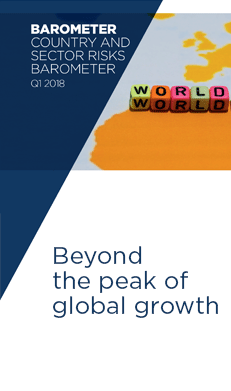

Albania
Synthesis
major macro economic indicators
| 2020 | 2021 | 2022 | 2023 (e) | 2024 (f) | |
|---|---|---|---|---|---|
| GDP growth (%) | -3.3 | 8.9 | 4.8 | 3.5 | 3.0 |
| Inflation (yearly average, %) | 1.6 | 2.0 | 6.7 | 5.0 | 4.0 |
| Budget balance (% GDP) | -6.7 | -4.6 | -3.7 | -2.5 | -3.0 |
| Current account balance (% GDP) | -8.7 | -7.7 | -7.7 | -6.0 | -5.5 |
| Public debt (% GDP) | 75.8 | 75.2 | 75.2 | 63.0 | 62.0 |
(e): Estimate (f): Forecast
STRENGTHS
- Labour cost competitiveness and potential productivity gains
- Effective monetary policy to control inflation
- Floating exchange rate regime
- Mining, energy, and tourism potential
- Proximity to the Italian market (Strait of Otranto)
- Commencement of EU accession negotiations in July 2022
WEAKNESSES
- Underdeveloped road, tourism, and energy infrastructure (hydroelectricity dependent on rainfall), low public investment
- Large informal economy, corruption, and organised crime, with European consequences, detrimental to state revenues and attractiveness
- Private investment concentrated in residential sector
- Low value-added exports, overshadowed by imports and limited diversification: tourism, clothing, foodstuffs, especially to Italy
- Brain drain and dependence on expatriate remittances (9% of GDP in 2022)
- Private consumption central to growth, despite poverty and unemployment
RISK ASSESSMENT
Moderate growth sustained by tourism
In 2024, growth will maintain at a comfortable level, primarily supported by household consumption (76% of GDP in 2022). Households will benefit from the strong performance of construction (12% of GDP in 2022) and tourism (direct and indirect contribution to GDP of 20%), which will continue its expansion in 2024 after reaching a record level in July 2023 in terms of tourist arrivals. However, the smooth operation of these two sectors will remain highly dependent on the economic situation in Europe, with the underperformance of European countries from which the majority of tourists and expatriate remittances originate posing a potential risk. At the same time, thanks to external financing, public investment (5% of GDP) is expected to be maintained, notably to improve the country's electrical capacity. The exploitation of its solar potential could help Albania curb intermittent supply cuts, attributed to rainfall and the seasonality of hydroelectricity (99% of electricity produced in 2021). The commissioning of the Karavasta plant, the country's first large-scale solar power plant built by the French company Voltalia with a loan from the International Finance Corporation, will inject an additional 140 MW into the grid starting from early 2024. Additionally, inflation will continue to ease in 2024, supported by ongoing lek appreciation and the slowdown in food price increases.
Structurally high public deficit
In 2024, the current account deficit will remain high, driven by the significant deficit in the goods balance. While appreciation of the lek will help reduce the cost of imports, especially energy, intermediate and capital goods imports, as well as exports, which have already been affected by the economic challenges faced in Europe, may be penalised. The government has implemented measures to mitigate the impact on exporters, such as extended payment deadlines for corporate income tax. However, growth in tourism will support the surplus in the services balance, and expatriate remittances will maintain the positive balance in the secondary income account, albeit negatively impacted by the lek's appreciation. Foreign direct investments (8% of GDP), mainly directed towards extractive industries and the energy sector, will continue to finance the deficit.
Furthermore, the Albanian government's decision to increase public salaries in 2024 will impact the budget deficit. However, simultaneous efforts in fiscal consolidation and the rise in revenues resulting from measures aimed at reducing informality and tax evasion will contain the increase in the deficit. In this context, the debt burden will continue to decrease thanks to strong economic performances and the lek’s appreciation (46% of the debt being denominated in foreign currencies).
EU accession negotiations hampered by corruption and disputes with Greece
Thanks to a parliamentary majority renewed for the third time in 2021, Prime Minister Edi Rama will continue his fight against corruption and organised crime in a bid to secure EU membership. Following the invasion of Ukraine, the European Union officially opened negotiations for the accession of Albania and North Macedonia. However, despite judicial system reform efforts and anti-corruption measures, short-term accession remains unlikely due to the magnitude of the reforms required. Nevertheless, reforms could accelerate with the EUR 6 billion growth plan proposed by the EU for Balkan candidate countries. The funds are expected to be distributed by way of grants (EUR 2 billion) and loans (EUR 4 billion), disbursed both upstream to help countries accelerate their reforms and downstream upon the completion of annual objectives. However, turbulent relations between the ruling party (the Socialist Party of Albania) and the main opposition party (Democratic Party of Albania) could impede the implementation of these reforms. Albania will continue to maintain good relations with Italy, with which it signed an agreement in early November 2023 a view to relocating asylum seekers on Albanian soil. The project, referred to the Constitutional Court by the opposition in early December 2023, should delay the opening of the first two centres financed by Italy, initially scheduled for spring 2024, pending the examination of the agreement's compliance. Additionally, tensions between Albania and Greece periodically resurface, often against the backdrop of reciprocal problems involving ethnic minorities, which will slow EU accession negotiations. In November 2023, Greece appeared to delay the opening of the first five accession chapters for Albania due to the arrest of a Greek-born opposition candidate elected in Albanian municipal elections, preventing him from taking oath.
Last updated: March 24



